Choosing the best cameras for professional photography depends a large part on what you shoot. When you’re working at the professional level, you’ll be looking at the flagship cameras in a manufacturer’s range, and these cameras are typically each developed to excel at a particular genre. For instance, the Canon EOS R3 is built for speed and appeals to wildlife and sport photographers, while a camera like the Nikon Z7 II and its large resolution sensor appeals to landscape photographers. And, of course, Sony’s Alpha 7 range has something for everyone. Check out our guide to find out which Sony A7 camera is best for your needs.
It’s really an exciting time for professional photographers. The rise of smartphone cameras has gradually chipped away at sales of even the best beginner cameras, and manufacturers are focusing their attention and investment at the professional end. Most significant camera announcements we see these days are at the professional level, and this is where we see the real innovation coming into play – Eye AF, 8K video, for example.
For this list of the best professional cameras, we’ve concentrated on stills photography and hybrid shooting. That said, we’ve also included a couple options for for videographers who might shoot video primarily but also shoot stills. For more like these, check out our guides to the best mirrorless cameras for video and the best 4K cameras for video.
Do professional photographers use mirrorless cameras?
One thing that is clear in compiling this list is the new dominance of mirrorless. As brands like Canon and Nikon invest in mirrorless systems, we’ve seen professional photographers migrate from their trusty DSLRs to new smaller, lighter mirrorless options that offer comparable, if not better, specifications.
All of the options we recommend as the best cameras for professional photography are mirrorless cameras. However, you could make a very strong case for adding the Nikon D850 and Canon EOS-1D X, two very powerful DSLRs. If you prefer the optical viewfinder and longer battery life of a DSLR, we’ve accounted for these in our guide to the Best professional DSLRs.
Is mirrorless cheaper than a DSLR?
At the moment, no. Mirrorless cameras – particularly at the professional end of the market – are every bit as expensive as their DSLR counterparts are and were. But global chip and supply shortages are contributing to driving prices up. What’s more, mirrorless is still relatively new and the volume isn’t there for most manufacturers. We can probably expect prices to come down in the future. But the best professional cameras will always cost a premium, as will the best mirrorless cameras.
How we graded the best cameras for professional photography
Rather than listing by genre, we’ve chosen our picks for the best professional camera by manufacturer. The reason for this being that you’ve likely already invested in a system when you’re at the point of taking the leap into self-employment and upgrading to a professional model. We assume you’ll want to keep using your existing lenses.
For a deeper dive into the many different camera types and features available, check out our range of camera buying guides.
Best Canon cameras for professional photography
Canon may have been late to the full-frame mirrorless party, but it’s EOS R system has really pushed the boat out with some exciting, new technology. With 8K video capability in the EOS R5 and advanced AF technology in the EOS R3, Canon makes some of the best cameras for professional photographers.
You can find the latest deals on these and other Canon full-frame cameras at Amazon UK and Amazon US.
Canon EOS R5
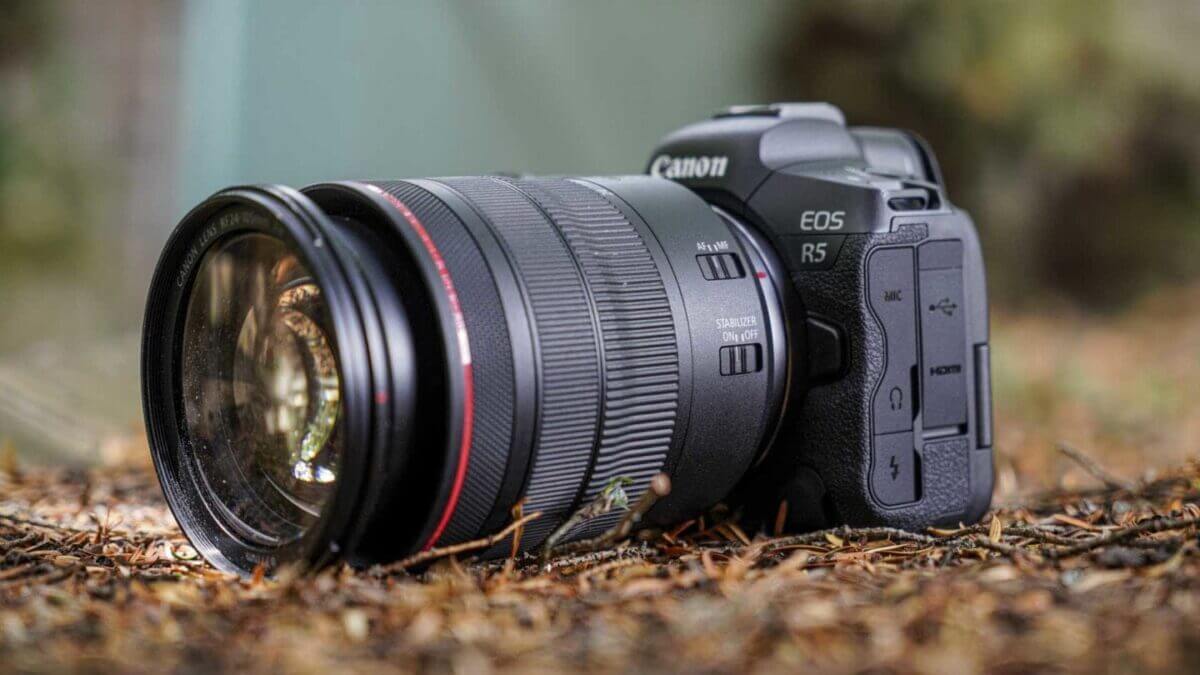
Specification
- Camera Type: Mirrorless
- Announced: 9th July 2020
- Sensor: 45Mp Full-frame Dual Pixel CMOS AF II
- Processor: Digic X
- Lens mount: RF
- Sensitivity range: Stills: ISO 100-51,200 expandable to ISO 50-102,400, Movies: ISO 100-25600, expandable to ISO ISO 51,200
- Metering: 384-zone metering with Evaluative metering (linked to All AF points), Partial metering (approx. 6.1% of viewfinder at centre), Spot metering: Centre spot metering (approx. 3.1% viewfinder at centre), Centre weighted average metering
- Shutter speed range: 1/8000sec-30 seconds and Bulb
- File formats: Raw + Jpeg/HEIF, MP4
- Maximum continuous shooting rate: Mechanical shutter: 12fps, Electronic shutter: 20fps
- Maximum video resolution: Uncropped, internal raw recording 8K video at up to 29.97fps in 4:2:2 10-bit in Canon Log (H.265) or 4:2:2 10-bit HDR PQ (H.265), Uncropped internal recording 4K video at up to 119.88fps in 4:2:2 10-bit in Canon Log (H.265) or 4:2:2 10-bit HDR PQ (H.265) 4:2:2 10-bit in Canon Log or 4:2:2 10-bit HDR PQ, 4K output over HDMI at up to 59.94fps
- Autofocus system: Dual Pixel CMOS AF II phase detection with 5940 points in stills and 4500 points in movie mode
- Viewfinder: 0.5-inch 5.76million-dot OLED electronic viewfinder with 120fps display and 0.76x magnification
- Screen: 3.15-inch 2.1-million dot vari-angle touchscreen
- Autofocus: Dual Pixel CMOS AF II with Advanced Animal AF (recognising dogs, cats and birds) supported in all video modes with 100% coverage and up to 1053 'AF segments'
- Stabilisation: In-body image stabilisation (IBIS) that works with lens IS and enables up to 8-stops of shutter speed compensation
- Storage: Dual slots, 1x CFexpress, 1x SDXC UHS-II
- Dimensions: 135.8 x 97.5 x 88mm
- Weight: 650 g / 738 g with card and battery
Although its position was technically usurped by the Canon EOS R3, the Canon EOS R5 is Canon’s flagship mirrorless camera and it was the most exciting camera announced in 2020.
Its 8K video capability stole most of the headlines when it was revealed, but the Canon R5 is at heart a 45Mp stills camera with an incredible autofocus system. This Dual Pixel CMOS AF II system has 5,940 selectable AF points and superb eye detection AF for humans, animals and birds that works in both video and stills mode.
Like the Canon EOS R6 announced at the same time, the EOS R5 has 5-axis in-body image stabilisation. In the R5 it enables shutter speed compensation of up to 8EV.
Canon pitches the R5 at around the same level as the Canon EOS 5D Mark IV, which means it’s designed for use by experienced enthusiast and professional photographers. It combines a healthy collection of button and dial controls with an excellent touch-control interface on the 3.15-inch 2.1-million dot vari-angle screen.
While 8K video is of limited appeal, the R5 is capable of producing superb results with the 4K HQ (High Quality) mode especially impressing. The still image quality is also excellent all the way up to around ISO 25,600.
Find the latest deals on the Canon EOS R5 at Amazon UK and Amazon US.
£4199
$3899For
- 45Mp full-frame sensor with full AF coverage
- 12fps/20fps continuous shooting with continuous AF
- Uncropped internal 8K video recording for up to 20 minutes
Canon EOS R3
Specification
- Camera Type: Mirrorless
- Announced: 14th September 2021
- Sensor: 24.1Mp Full-frame BSI stacked CMOS
- Processor: Digic X
- Lens mount: RF
- Sensitivity range: Stills: ISO 100-102,400 expandable to ISO 50-204,800, Video: ISO 100-25,600 expandable to 100-102,400
- Metering: 384-zone metering with Evaluative metering (linked to All AF points), Partial metering (approx. 5.9% of viewfinder at centre), Spot metering: Centre spot metering (approx. 2.9% viewfinder at centre), Centre weighted average metering
- Shutter speed range: Mechanical shutter: 30- 1/8,000 sec and Bulb, Electronic shutter: 30-1/64,000 sec
- Still file formats: Raw + Jpeg/HEIF
- Maximum continuous shooting rate: Mechanical shutter / 1st curtain electronic: 12fps for 1000+ Jpeg or 1000 raw, Electronic shutter: 30fps for 540 Jpegs or 150 raw images
- Main video resolutions: 6K DCI (17:9) 6000 x 3164 (59.94, 50, 29.97, 25, 24, 23.98fps) raw, 4K DCI (17:9) 4096 x 2160 (59.94, 50, 29.97, 25, 24, 23.98fps) intra or inter frame / light inter frame 4K UHD (16:9) 3840 x 2160 (119.9, 100, 59.94, 50, 29.97, 25, 23.98 fps) intra or inter frame Full HD (16:9) 1920 x 1080 (119.9, 100, 59.94, 50, 29.97, 25, 23.98 fps) intra or inter frame Full HD (16:9) 1920 x 1080 HDR (29.97, 25 fps) inter frame
- Video conatiner formats: MP4, raw (CRM)
- Colour sampling: 6K raw 12bit, 4K/ Full HD - 4:2:0 8-bit or 4:2:2 10bit
- Log: Canon Log 3
- Autofocus system: Dual Pixel CMOS AF II phase detection with 1,053 points
- Viewfinder: 0.5-inch 5.76million-dot OLED electronic viewfinder with 120fps display and 0.76x magnification
- Screen: 3.2-inch 4.15-million dot vari-angle touchscreen
- Stabilisation: In-body image stabilisation (IBIS) that works with lens IS and enables up to 8-stops of shutter speed compensation
- Storage: Dual slots, 1x CFexpress, 1x SDXC UHS-II
- Dimensions: 150x 142.6 x 87.2mm
- Weight: 822g body only, 1015g with card and battery
While Canon says that the EOS R3 sits below the Canon EOS-1D X Mark III in the company’s line-up, there can be little doubt that the new 24.1MP full-frame mirrorless camera will attract the attention of many of the flagship DSLR’s users. It’s aimed at the same pro sports and news photographer audience and has a fabulous feature set to keep them happy.
Canon used a full-frame backside-illuminated stacked CMOS sensor inside the Canon EOS R3 and paired it with the Digic X processing engine to deliver quick data readout and minimise rolling shutter. It offers an excellent blend of resolution, noise control and file size with blistering AF performance.
What’s more, the R3 can shoot raw or Jpeg files at up to 30fps with full exposure metering and autofocus (AF) tracking when the electronic shutter is selected. It’s a great choice of camera for sport, action and news photography.
The R5 and R6 were significant introductions for Canon when they launched in 2020. They gave significant depth to the EOS R system. But the addition of the EOS R3 takes things up a notch with its ability to shoot at 30fps, Eye Control AF and a high-resolution vari-angle touchscreen. It’s also the first double-gripped mirrorless camera, and while Canon says that it sits below the EOS-1D X Mark III, the R3 looks set to poach a few flagship DSLR sales and convert more professional photographers to mirrorless technology.
Canon has shown us a vision of the future for mirrorless cameras and while the R3 is beyond the budget of many photographers, the AI that it employs will trickle down to more affordable cameras.
Find the latest deals on the Canon EOS R3 at Amazon UK and Amazon US.
£5880
$5999 / €6689.99For
- 24Mp full-frame sensor with full AF coverage
- 12fps/30fps continuous shooting with continuous AF
- Eye Control AF
Best Nikon cameras for professional photography
Like Canon, Nikon was also a late entry into the full-frame mirrorless market, but its first-generation Z series cameras marked an impressive debut. Since then, the Z6 II and Z7 II have brought more processing power to Nikon’s flagship duo, while the Nikon Z9 looks to be in a league of its own.
You can find the latest deals on these and other Nikon Z series cameras at Amazon UK and Amazon US.
Nikon Z9
Specification
- Camera type: Full-frame mirrorless camera
- Announced: 28th October 2021
- Lens mount: Nikon Z
- Sensor: Full-frame (FX 35.9 x 23.9mm) 45.7MP stacked backside illuminated (BSI) sensor
- Processing engine: Expeed 7
- Stabilisation: 5-axis sensor shift giving 6EV shutter speed compensation
- Sensitivity: ISO 64-25,600, expandable to ISO 32-102,400
- Maximum continuous shooting rate: 20fps for up to 1000+ raw (high efficiency) files or 685 raw (high efficiency *) files, 30fps for up to 1000+ normal-quality Jpegs, or 120fps normal-quality 11Mp Jpegs
- Autofocus system: Hybrid with phase and contrast detection
- Phase detection points: 493
- AF-area modes: Pinpoint (available in photo mode only), single-point, dynamic-area (S, M, and L; available in photo mode only), wide-area (S and L), and auto-area AF, 3D-tracking (available in photo mode only), subject-tracking AF (available in video mode only)
- Video resolution: 8K (7680 x 4320): 30p (progressive)/25p/24p, 4K (3840 x 2160): 120p/100p/60p/50p/30p/25p/24p, Full HD (1920 x 1080): 120p/100p/60p/50p/30p/25p/24p
- Video file format: MOV, MP4
- Video compression: Apple ProRes 422 HQ (10 bit), H.265/HEVC (8 bit/10 bit), H.264/AVC (8 bit)
- Viewfinder: 0.5-inch 3.69-million-dot, 3,000-nit OLED viewfinder
- Screen: 3.2-inch 2,100,000-dot 4-way-tilting touch-screen
- Storage: Dual XQD/CFexpress
- Dimensions (W x H x D): 149 x 149.5 x 90.5 mm / 5.9 x 5.9 x 3.6 inches
- Weight: 1340 g / 2 lb. 15.3 oz.with battery and memory card but without body cap and accessory shoe cover, Body only: 1160g / 2 lb. 9 oz.
The Nikon Z9 offers just about everything professional and enthusiast photographers might want from a camera and put it into a relatively compact (yet twin-gripped) weather-sealed body. A resolution of 45.7Mp promises to capture a high level of detail without over-stretching the camera’s noise control.
There’s also 20fps full-resolution shooting for raw files, 30fps for Jpegs and 120fps shooting at 11Mp, paired with an excellent AF system with super-sticky Eye-detection.
The Nikon Z9 goes beyond what’s offered by the Nikon D6 while at £5,299/€6,299 its costs around £1,000 less.
£5299
€6299For
- New 45.7Mp full-frame sensor sensor
- Advanced AF system
- Durable, weatherproof build
Nikon Z7 II
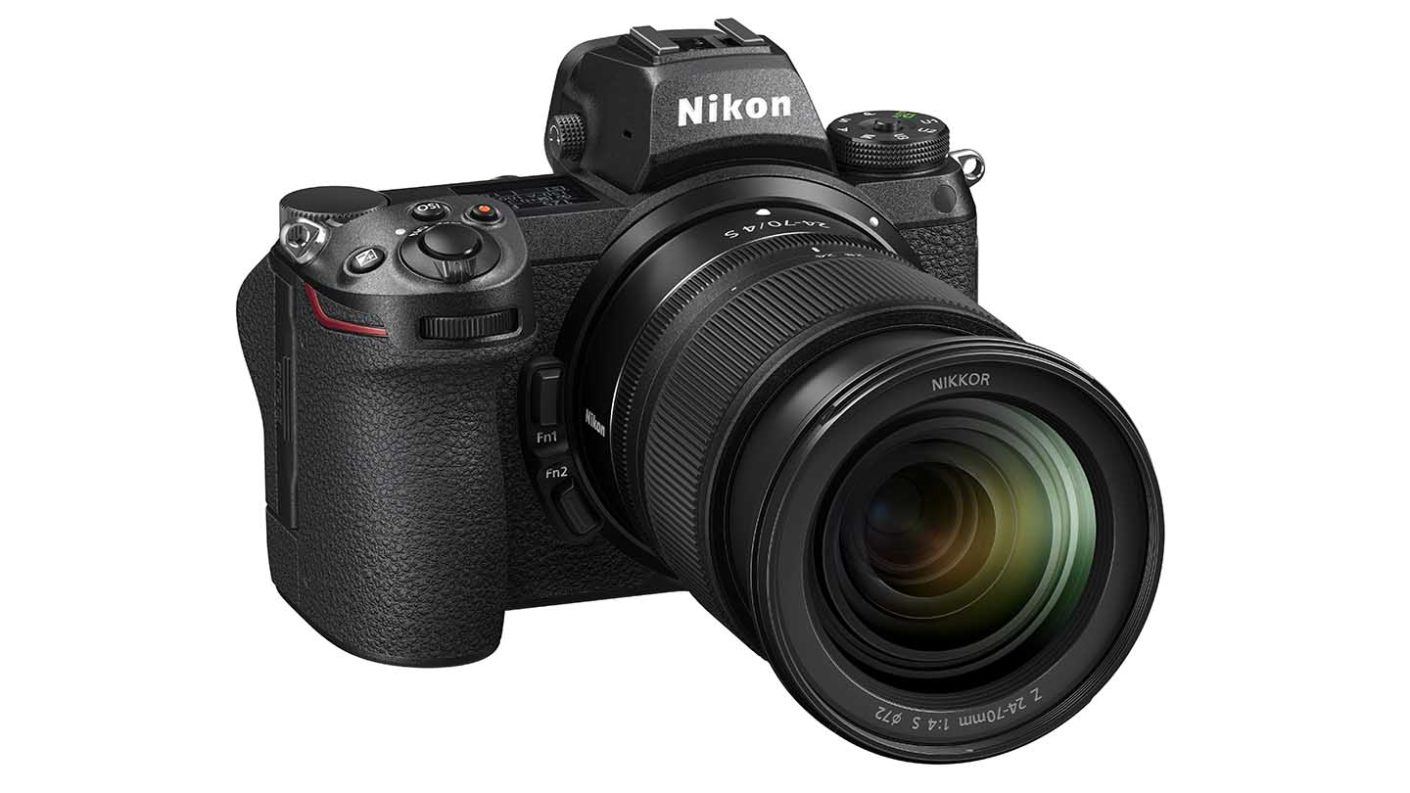
Specification
- Camera type: Full-frame mirrorless camera
- Announced: 14th October 2020
- Lens mount: Nikon Z
- Sensor: Full-frame (FX 35.9 x 23.9mm) 45.7MP backside illuminated (BSI) sensor
- Processing engine: Dual Expeed 6
- Stabilisation: 5-axis in-body VR
- Sensitivity: ISO 64-25,600, expandable to ISO 32-102,400
- Maximum continuous shooting rate: 10fps for up to 200Jpegs or 77 12-bit uncompressed raw files, 9fps with 14-bit raw files
- Autofocus system: Hybrid with phase and contrast detection
- Phase detection points: 493
- Video resolution: 4K (3840 x 2160) 60/50/30/25/24p, Full-HD (1920 x 1080) 120/100/60/50/30/25/24p, Slow-motion mode 1920 x 1080 30p x4/25p x4/24p
- Viewfinder: 0.5-inch 3.69-million-dot electronic viewfinder
- Screen: 3.2-inch 2,100,000-dot tilting touch-screen
- Storage: Dual slot 1 XQD/CFexpress and 1 SD/SDHC/SDXC
- Dimensions (W x H x D): 134 x 100.5 x 69.5mm / 5.3 x 4 x 2.8-inches
- Weight: 705g with battery and memory card but without body cap, 615g body only
While the 45.7Mp Nikon Z7 II has a lot in common with the excellent Nikon Z7 and uses much of the same technology (including the same sensor), the mark II camera has a second memory card slot which means it addresses the main concern that photographers had about the original camera. One slot accepts XQD or CFexpress cards while the other is for SD-type cards and is UHS-II compliant
Nikon also doubled the Z7 II’s processing power in comparison with the Z7 II by giving it two Expeed 6 processing engines. This enabled a boost in the continuous shooting rate from 9fps to 10fps and enables 4K shooting at 60P.
That extra processing power also enables Eye-detection AF for humans and animals in video mode as well as stills, and enhances the low-light capability of the autofocus system.
The Nikon Z7 II has the same build and handling as the Z7, Z6 and Z6 II, and it’s the best interface available in a Nikon camera to date.
You can find the latest deals on the Nikon Z7 II at Amazon UK and Amazon US.
£2999
€3442 / $2996.95For
- High-quality sensor
- Excellent user interface and control layout
- Weatherproof build
Best Sony cameras for professional photography
While Sony’s A7 series cameras offer a big resolution model for landscape and portrati photographers, even a video-centric model in the A7S III, the company’s Alpha 1 is perhaps the true all-rounder on this list of best professional cameras.
For the latest deals on these and other Sony full-frame cameras, visit Amazon UK and Amazon US.
Sony A1
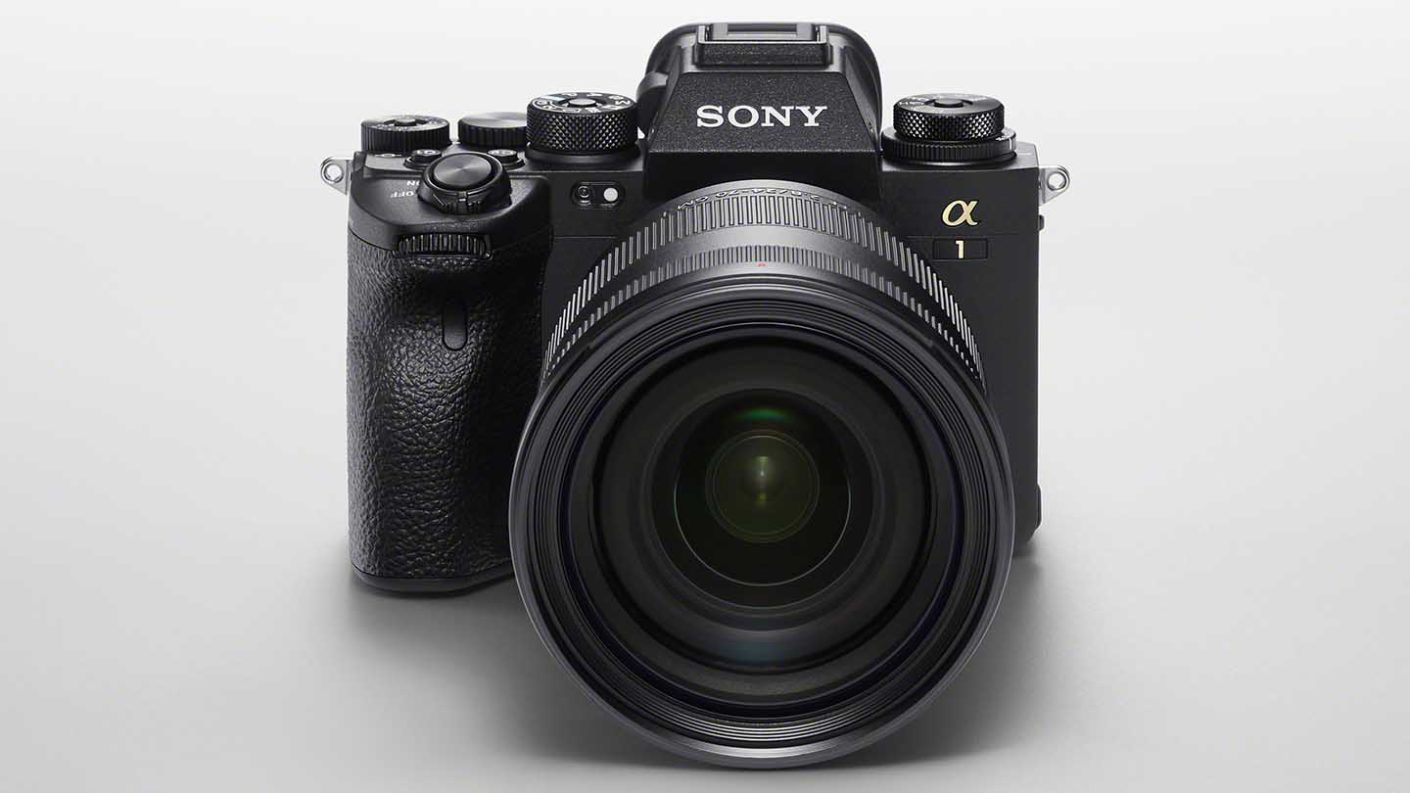
Specification
- Camera type: Full-frame mirrorless
- Announced: 26th January 2021
- Sensor: 50.1Mp full frame (35.9 x 24.0mm), Exmor RS CMOS sensor
- Lens mount: FE
- Sensitivity range: Stills: ISO 100-32000 (expandable to ISO 50 to ISO 102400) Video: ISO ISO 100-32000 (expandable to ISO 100-12800)
- Still Image format: Jpeg, HEIF, raw (Sony ARW 4.0)
- Video format & compression: XAVC S: MPEG-4 AVC/H.264, XAVC HS: MPEG-H HEVC/H.265
- 8K Video (XAVC HS): 7680 x 4320 (4:2:0, 10bit, NTSC) (Approx.): 30p(400Mbps / 200 Mbps), 24p(400Mbps / 200 Mbps), 7680 x 4320 (4:2:0, 10bit, PAL) (Approx.): 25p(400Mbps / 200 Mbps)
- 4K Video (XAVC HS): 3840 x 2160 (4:2:0, 10bit, NTSC) (Approx.): 120p (200Mbps), 60p (150Mbps / 75Mbps / 45Mbps), 24p (100Mbps / 50Mbps / 30Mbps); 3840 x 2160 (4:2:0, 10bit, PAL) (Approx.): 100p (200Mbps), 50p (150Mbps / 75Mbps / 45Mbps); 3840 x 2160 (4:2:2, 10bit, NTSC) (Approx.): 120p (280Mbps), 60p (200Mbps / 100Mbps), 24p (100Mbps / 50Mbps); 3840 x 2160 (4:2:2, 10bit, PAL) (Approx.): 100p (280Mbps), 50p (200Mbps / 100Mbps)
- 4K Video (XAVC S): 3840 x 2160 (4:2:0, 8bit, NTSC) (Approx.): 120p (200Mbps), 60p (150Mbps), 30p (100Mbps / 60Mbps), 24p (100Mbps / 60Mbps); 3840 x 2160 (4:2:0, 8bit, PAL) (Approx.): 100p (200Mbps), 50p (150Mbps), 25p (100Mbps / 60Mbps); 3840 x 2160 (4:2:2, 10bit, NTSC) (Approx.): 120p (280Mbps), 60p (200Mbps), 30p (140Mbps), 24p (100Mbps); 3840 x 2160 (4:2:2, 10bit, PAL) (Approx.): 100p (280Mbps), 50p (200Mbps), 25p (140Mbps)
- 4K Video (XAVC S-I): 3840 x 2160 (4:2:2, 10bit, NTSC) (Approx.): 60p (600Mbps), 30p (300Mbps), 24p (240Mbps); 3840 x 2160 (4:2:2, 10bit, PAL) (Approx.): 50p (500Mbps), 25p (250Mbps)
- Movie functions: Audio Level Display, Audio Rec Level, PAL/NTSC Selector, Proxy Recording (1280 x 720 (6Mbps), 1920 x 1080(9Mbps), 1920 x 1080(16Mbps)), TC/UB, Auto Slow Shutter, Gamma Disp. Assist, raw output(HDMI)
- Autofocus system: Hybrid AF with 759 phase detection points and 425 contrast detection points, Still images: Human (Right/Left Eye Select) / Animal (Right/Left Eye Select) / Bird, Movie: Human (Right/Left Eye Select), sensitive down to -4EV
- Maximum continuous shooting rate: Mechanical shutter: 10fps, Electronic shutter 30fps
- Viewfinder: 0.64-inch 9,437,184-dot EVF with 100% coverage and up to 0.9x magnification. It also offers 0.90x viewfinder magnification, 41° diagonal field of view with 25mm-high eyepoint
- Screen: 3-inch 1,440,000-dot tilting touchscreen
- Stills shutter speed range: Mechanical shutter: 1/8000-30sec plus Bulb, Electronic shutter: 1/32000-30sec plus Bulb
- Max flash sync speed (full-frame): Mechanical shutter: 1/400 sec, Electronic shutter: 1/200 sec
- Image stabilisation: 5-axis giving up to 5.5EV compensation
- Storage: Dual SD/SDHC/SDXC (UHS-I/II) & CFexpress Type A slots
- Connection ports: Sync, 3.5mm headphone, 3.5mm mic, LAN
- Battery: NP-FZ100 rechargeable Li-ion battery giving 400 shots with the viewfinder or 530 with the screen
- Dimensions (WxHxD): 128.9 x 96.9 x 80.8mm / 5 1/8 x 3 7/8 x 3 1/4 inches
- Weight (including battery & memory card): 737g / 1 lb 10.0 oz
The Alpha A1 is Sony’s most advanced camera to date, it combines a high-resolution full-frame sensor with high-speed performance. It features a new 50.1Mp full-frame stacked Exmor RS image sensor and can perform up to 120 AF/AE calculations per second.
Thanks to its impressive processing power, the Sony A1 can shoot at up to 30fps (frames per second) while its large buffer allows for sequences of up to 155 full-frame compressed RAW images or 165 full-frame JPEGs to be shot at that rate.
In addition to improved Real-time Eye AF for humans and animals, the Alpha 1 uses high-level subject recognition technology for Real-time Eye AF for birds. Algorithms also maintain the AF tracking if a sitting bird takes off or the framing changes.
The Sony A1 is the first Sony Alpha series camera to feature 8K 30p 10-bit 4:2:0 XAVC HS video recording. It’s also capable of shooting 4K 120p / 60p 10-bit 4:2:2 video and offers S-Cinetone colour. It uses 8.6K oversampling for enhanced resolution and, naturally, the 8K footage can be used for 4K editing during post-production.
The Sony A 1 has a 9.44 million dot OLED Quad-XGA electronic viewfinder, with a refresh rate of up to 240 fps, ensuring no blackout, delivering the highest resolution in its class. In addition, there’s a 3-inch 1,440,000-dot tilting touchscreen that features the revised menu arrangement and more extensive touch-control that was first seen in the Sony A7S III.
In case a resolution of 50Mp isn’t enough, the Sony A1 has Sony’s Pixel Shift Multi Shooting mode onboard to enables 16 full-resolution images to be composited.
You can order the Sony A1 from Wex Photo Video and Park Cameras in the UK and Adorama or B&H Photo Video in the USA. You can also find the latest Sony A1 offers at Amazon UK and Amazon US.
£6500
$6500For
- Excellent combination of speed and resolution
- Great range of video features including 8K video
- Superb electronic viewfinder
Sony A7S III
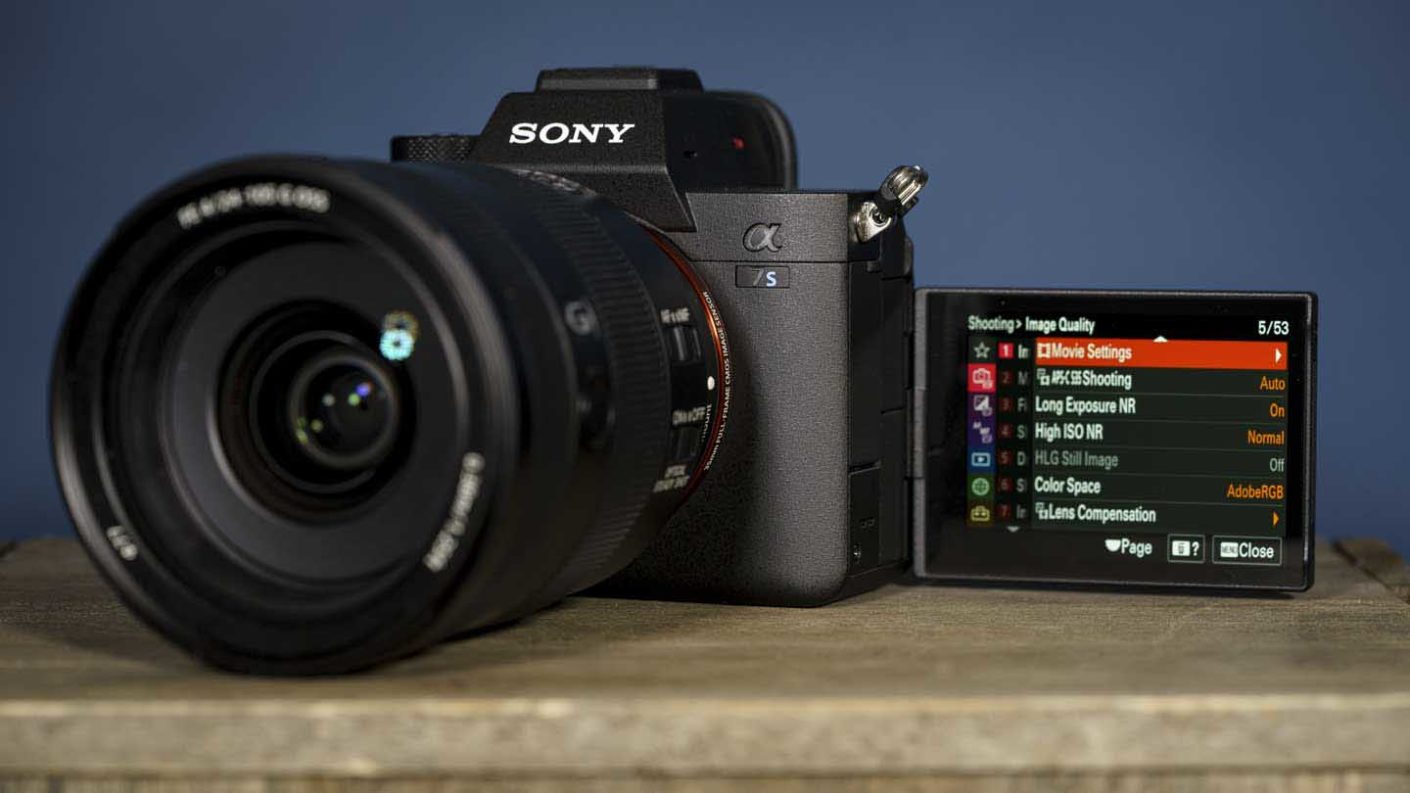
Specification
- Camera type: Full-frame mirrorless
- Announced: 28th July 2020
- Sensor: Full-frame 12.1Mp BSI CMOS
- Processing engine: Bionz XR
- Sensitivity: Video: ISO 80-102,400 expandable ISO 40-409,600. ISO base in S-Log is ISO 640 but it can be expanded down to ISO 160. Stills: ISO 80-102,400 expandable 40-409,600
- Autofocus system: Hybrid with 759 phase detection points and 425 contrast detection points, Real Time Eye AF (Human and Animal for stills, Human for video)
- Stabilisation: 5-axis IBIS and digital, up to 5.5EV shutter speed compensation
- Video resolution: 4K at up 120fps and 1080p at 240fps, 10-bit and 4:2:2 colour, 16-bit raw video over HDMI
- Video file formats: XAVC S,XAVC HS
- Video compression: XAVC S: MPEG-4 AVC/H.264, XAVC HS: MPEG-H HEVC/H.265
- 4K Video details: XAVC HS 4K 3840 x 2160 (4:2:0, 10bit, NTSC): 120p (200Mbps), 60p (150Mbps / 75Mbps / 45Mbps), 24p (100Mbps / 50Mbps / 30Mbps); 3840 x 2160 (4:2:0, 10bit, PAL): 100p (200Mbps), 50p (150Mbps / 75Mbps / 45Mbps); 3840 x 2160 (4:2:2, 10bit, NTSC): 120p (280Mbps), 60p (200Mbps / 100Mbps), 24p (100Mbps / 50Mbps); 3840 x 2160 (4:2:2, 10bit, PAL): 100p (280Mbps), 50p (200Mbps / 100Mbps) XAVC S 4K 3840 x 2160 (4:2:0, 8bit, NTSC): 120p (200Mbps), 60p (150Mbps), 30p (100Mbps / 60Mbps), 24p (100Mbps / 60Mbps); 3840 x 2160 (4:2:0, 8bit, PAL): 100p (200Mbps), 50p (150Mbps), 25p (100Mbps / 60Mbps); 3840 x 2160 (4:2:2, 10bit, NTSC): 120p (280Mbps), 60p (200Mbps), 30p (140Mbps), 24p (100Mbps); 3840 x 2160 (4:2:2, 10bit, PAL): 100p (280Mbps), 50p (200Mbps), 25p (140Mbps) XAVC S-I 4K 3840 x 2160 (4:2:2, 10bit, NTSC) (Approx.): 60p (600Mbps), 30p (300Mbps), 24p (240Mbps); 3840 x 2160 (4:2:2, 10bit, PAL): 50p (500Mbps), 25p (250Mbps)
- Gamut: S-Log2 and S-Log3, S-Gamut3.Cine and S-Gamut3
- Slow and Quick (S&Q) mode options: NTSC: 1fps,2fps,4fps,8fps,15fps,30fps,60fps,120fps, 240fps4, PAL: 1fps,2fps,3fps,6fps,12fps,25fps,50fps,100fps, 200fps
- Still File formats: Raw, JPG, HEIF
- Screen: 3-inch 1,440,000-dot vari-angle touchscreen
- Viewfinder: 0.64-inch type 9,437,184-dot OLED electronic viewfinder, with refresh rate up to 120fps, adjustable magnification up to 0.9x
- Maximum continuous shooting rate: 10fps with mechanical or electronic shutter for up to 1000 uncompressed raw files when a CFexpress Type 1 card is used
- Storage: Dual: SD/SDHC/SDXC (UHS-II) and CFexpress Type A
- Dimensions (W x H x D): 128.9 x 96.9 x 80.8mm / 5 1/8 x 3 7/8 x 3 1/4 inches
- Weight: 699g / 1 lb 8.7 oz
After the 8K-capabilities of the Canon EOS R5 were announced, the Sony A7S III might seem a bit of an anti-climax. Some videographers were probably hoping for a big jump in resolution from the 12mp A7S II. However, Sony already has the 61Mp A7R IV and the 24Mp A7 III, so sticking with 12Mp means that the A7S III has even better low-light capability than its predecessor but with a much better autofocus system, a vari-angle screen and the highest-resolution viewfinder around.
The A7S III is about more than grabbing the headlines for its resolution; it promises to make capturing 4K video easier than before and for that video quality to be the best 4K footage you can get from a Sony camera. It doesn’t disappoint as the quality of the footage is superb.
The A7S III’s handling and control arrangement is a major improvement upon the A7S II, but it’s also much better than any of Sony’s other cameras.
And as good as the Sony A7S III is for experienced videographers, it’s also capable of producing superb 4K video without using some of the advanced features. So if you don’t have an external monitor/recording device and you’re relatively new to grading Log files, you can still great great results.
£3800
€4200 / $3499For
- Large pixels for great low-light performance
- 4K full-pixel readout without binning and 10-bit depth 4:2:2 colour available in all recording formats
- Vari-angle touchscreen and class-leading electronic viewfinder
Best Fujifilm cameras for professional photography
Fujifilm’s X-T4, though APS-C format, is a fantastic all-rounder that can do many things well. But don’t underestimate Fujifilm’s mirrorless medium format GFX series. With prices and body sizes decreasing, suddenly the beautiful clarity of medium format photography is something that many budding professionals can afford in their kit bag.
Find the latest deals on these and other Fujifilm cameras at Amazon UK and Amazon US.
Fujifilm GFX 50S II
Specification
- Camera type: Medium format mirrorless
- Announced: 2nd September 2021
- Sensor: 51.4Mp Medium format (43.8 x 32.9mm) CMOS with Bayer colour filter array
- Maximum image size: 8256 x 6192
- Processor: X Processor 4
- Lens mount: Fujifilm G
- Autofocusing: Contrast detection with Contrast Rapid AF and up to 425 user-selectable points
- Viewfinder: Fixed 0.5-inch 3.69million-dot EVF with 0.77x magnifications 50fps
- Screen: 3-direction tilting 3.2-inch 2.36million-dot touchscreen
- Maximum continuous shooting rate: 3fps
- Sensitivity range: Standard ISO 100-12,800, expandable to ISO 50-102,400
- Image stabilisation: In-body 5-axis giving 6.5EV compensation
- Max video resolution: Full-HD (1920 x 1080) 4:2:0 8-bit
- Film Simulation Modes: 19 modes: Provia/Standard, Velvia/Vivid, Astia/Soft, Classic Chrome, Pro Neg.Hi, Pro Neg.Std Classic Neg., Nostalgic Neg., Eterna/Cinema, Eterna Beach Bypass, Acros, Acros + Ye Filter, Acros + R Filter, Acros + G Filter, Black & White, Black & White + Ye Filter, Black & White + R Filter, Black & White + G Filter, Sepia
- Storage: Dual SD/SDHC/SDXC UHS-II
- Battery: NP-W325, life of455 images
- Dimensions: 150 x 104 x 44mm
- Weight: 900g
As Fujifilm’s most affordable medium format camera, the GFX50S II has to make some compromises upon the GFX100S and GFX100 above it in the line up. However, it doesn’t feel built to a price or especially limiting, you get the full medium format experience without excessive weight or hassle.
It feels great in your hand and, with the exception of the exposure compensation button and minor niggle with the Q button in the early days, the control arrangement is very good. It’s also pretty responsive, and while it’s not the right choice of camera for sport or action photography, it’s great for landscape, still life and generally photography. It’s also a very capable portrait camera.
With the GF35-70mm F4.5-5.6 WR lens mounted, it also takes up a fraction of the space that you might expect to need to dedicate to a medium format camera. It’s also a weight that you can carry all day on your shoulder without complaint.
In our tests, we found that the GFX50S II’s dynamic range is very good and you won’t lose highlight or shadow detail quickly. There’s a natural-looking balance to images, and should you need to underexpose to capture more detail in bright areas, the images can withstand significant shadow-brightening at the lower ISO settings.
£3499
$3999 / €3999 / £3899 / $4499 / €4499For
- 43.8 x 32.9mm sensor
- Compact for medium format
- Weatherproof
Best Panasonic cameras for professional photography
The Panasonic GH5 landed on the wishlists of many videographers when it was announced some years ago, and since then Panasonic has cultivated a line-up of cameras aimed squarely at professional users. Its Lumix S series of full-frame cameras can be complex to use, but are seriously powerful bodies that will suit any job.
Find the latest deals on Panasonic Lumix S series cameras at Amazon UK and Amazon US.
Panasonic S1R
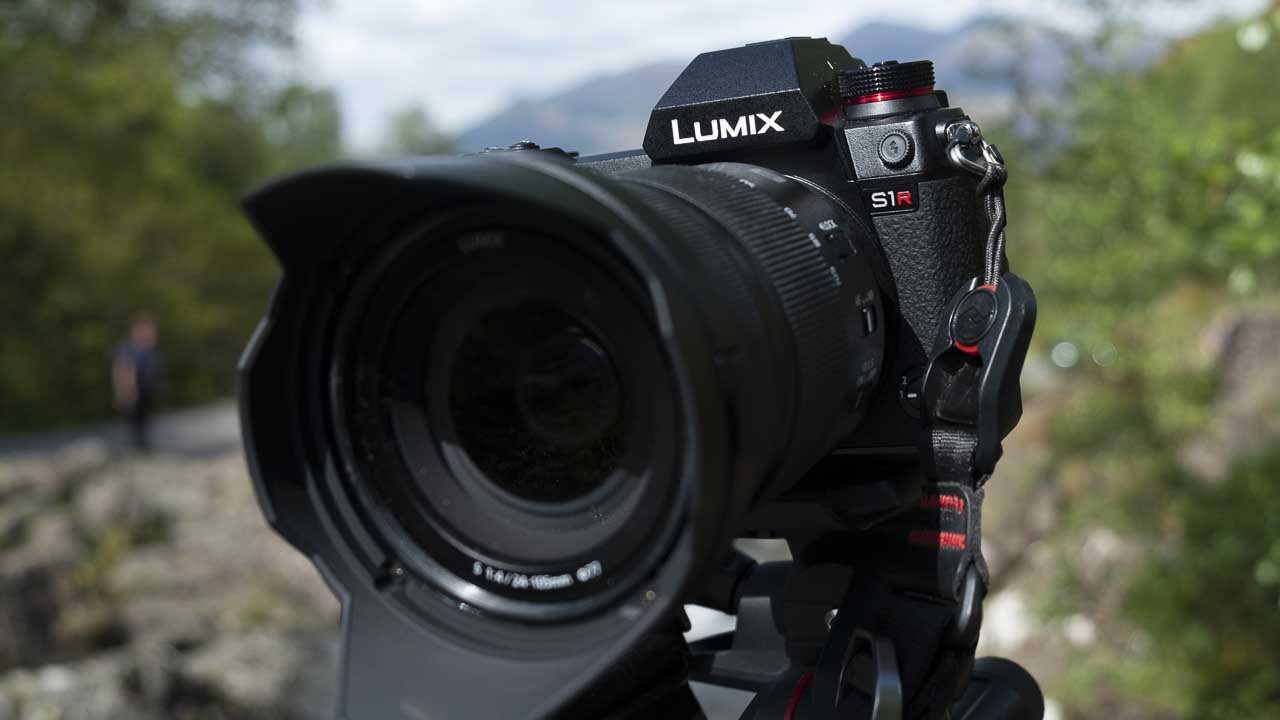
Specification
- Camera type: Full-frame mirrorless
- Announcement: 1st February 2019
- Sensor: 47.3MP full-frame (36x24mm)
- Aspect Ratios: 2:3, 4:3, 1:1, 16:9, 2:1 and 65:24
- Sensitivity range: ISO 100-25,600, expandable to ISO 50-51,200
- Video: 4K (3840×2160) at 60fps and 150Mbps
- 6K Photo / 4K Photo: 6K PHOTO: 30 frames/sec 4K PHOTO: 60 frames/sec, 30 frames/sec, Extracted image format: Jpeg
- Maximum continuous shooting rate: Mechanical shutter: AFS/MF: H: 9 frames/sec, AFC: H: 6 frames/sec , Electronic shutter: AFS/MF: H: 9 frames/sec, AFC: H: 5 frames/sec
- Stabilisation: Dual IS 2 to 7EV compensation
- Viewfinder: 5,760,000-dot OLED
- Screen: 3.2-inch 2,100,000-dot triaxial tilt touchscreen
- Autofocus system: Contrast detection with 225 areas, Auto Detection (Face, Eye, Body, Animal)
- Storage: Dual ports: XQD/CFexpress and SD/SDHX/SDXC UHS-II
- Dimensions (HxWxD): 110x148.9x96.7mm
- Weight: 1016g
The Panasonic S1R has a sensor with an effective pixel count of 47.3 million. Unlike Panasonic’s G-Series Micro Four Thirds cameras which have a native aspect ratio of 4:3, the S1R’s 36x24mm sensor is a 3:2 device. However, there are also aspect ratio settings of 4:3, 1:1, 16:9, 2:1 and 65:24 should you want them.
Given the high pixel count of the Panasonic S1R in comparison with the S1, it’s no surprise to find it has a more limited sensitivity range. The standard range is ISO 100-25,600, and there are expansion settings to take it to ISO 50-51,200. That upper value is the same as the Lumix S1’s highest native setting.
Panasonic is aiming the Lumix S1R at professional photographers who want a high-resolution camera. For many, the 47Mp resolution is likely to be enough, but like the Panasonic S1 and Panasonic G9, the Lumix S1R also has a High Resolution mode.
When this is mode is activated, the camera shoots a series of eight images in quick succession. Using the in-body stabilisation mechanism, it moves the sensor a fraction between each shot. The camera then merges the images to create one much larger raw file.
When the aspect ratio is 3:2, using High Resolution Mode results in 16,736 x 11,186-pixel images. That means the images have 187million pixels! At 300ppi this enables you to create 141.7 x 94.56cm (55.787 x 37.227-inch) prints.
The Lumix S1R is an advanced camera with plenty of customisability and a dual-tilting touchscreen. There’s also a class-leading electronic viewfinder, and a nippy AF system. And, despite the already high pixel count, there’s a High Resolution mode that produces 187Mp images that are superb but challenging for computers.
It’s a complex camera, but well thought out and capable of producing superb results. Also, it sets a new benchmark for electronic viewfinders, with a super-smooth, high-detail view. And while the screen may not flip out for viewing from the front, its robust hinges allow it to tilt horizontally and vertically. This makes it useful for all sorts of photography as well as shooting video.
Naturally, the main reason for investing in a 47Mp camera is to produce images with lots of detail. The Panasonic Lumix S1R certainly delivers on this score. If you want to take things up a notch, there’s the High Resolution mode.
£2899
$3698For
- Robust build
- High-quality high-resolution images
- Excellent handling with lots of customisation
Panasonic S1H
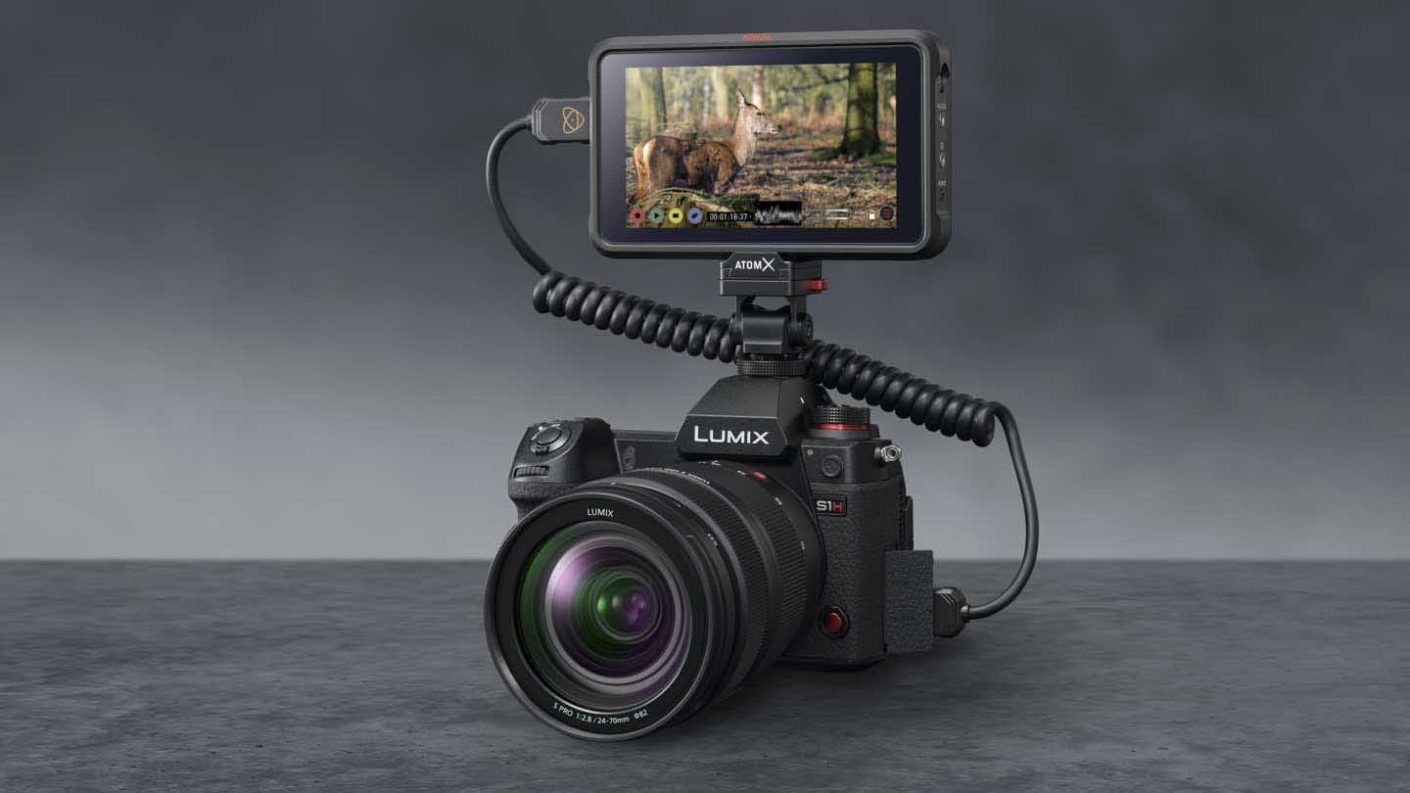
Specification
- Sensor: 24.2MP full frame CMOS
- Video: 6K (5.9K) 3:2 24p, 5.9K 16:9 up to 30p, C4K/4K UHD up to 60p
- Autofocus: 225-area DFD contrast AF
- ISO: Dual Native ISO; 100-51,200 (50-102,400 exp.)
In early 2020 Panasonic announced that via a strategic partnership with Atoms it had developed new firmware for the Lumix S1H that enables the camera to output a maximum 5.9K/29.97p RAW video data to the Atomos Ninja V.
Shortly after this announcement, the Panasonic S1H became the first ‘Netflix-approved’ camera on the market.
The S1H is aimed at serious filmmakers, but its price tag is under the the £4,000 threshold, and it packs some serious firepower.
Panasonic’s flagship full-frame mirrorless camera offers 6K video recording and 10-bit 60p 4K/C4K, aided by a 35.6 x 23.8mm, 24.2-megapixel full-frame CMOS sensor. It can record 6K at 24p at a 3:2 aspect ratio, 5.9K at 30p in 16:9, as well as 10-bit 4K/Cinema 4K footage at 60p using the Super 35mm image area.
As if that isn’t enough, it can record 4:2:2 10-bit 4K footage at 30p over the full image area.
The Panasonic S1H also delivers 14 stops of dynamic range – the same as Panasonic’s cinema cameras – along with a slew of other video specifications aimed at professionals such as Panasonic’s V-Log/V-Gamut log modes, HDR in HLG (Hybrid Log Gamma), 4:2:2 10-bit HDMI output and Anamorphic 4:3 modes.
For
- Shoots 6K raw
- Records 4K at 60p
- 14 stops dynamic range
Best Olympus cameras for professional photography
Olympus, now the OM System, makes image stabilisation that is second to none, along with a slew of other features (such as Pixel Shift, Live Composite mode) that are incredibly useful for professional users. Its OM-D E-M1 line is the first place you should look.
Find the best deals on Olympus OM-D E-M1 series cameras at Amazon UK and Amazon US.
Olympus OM-D E-M1X
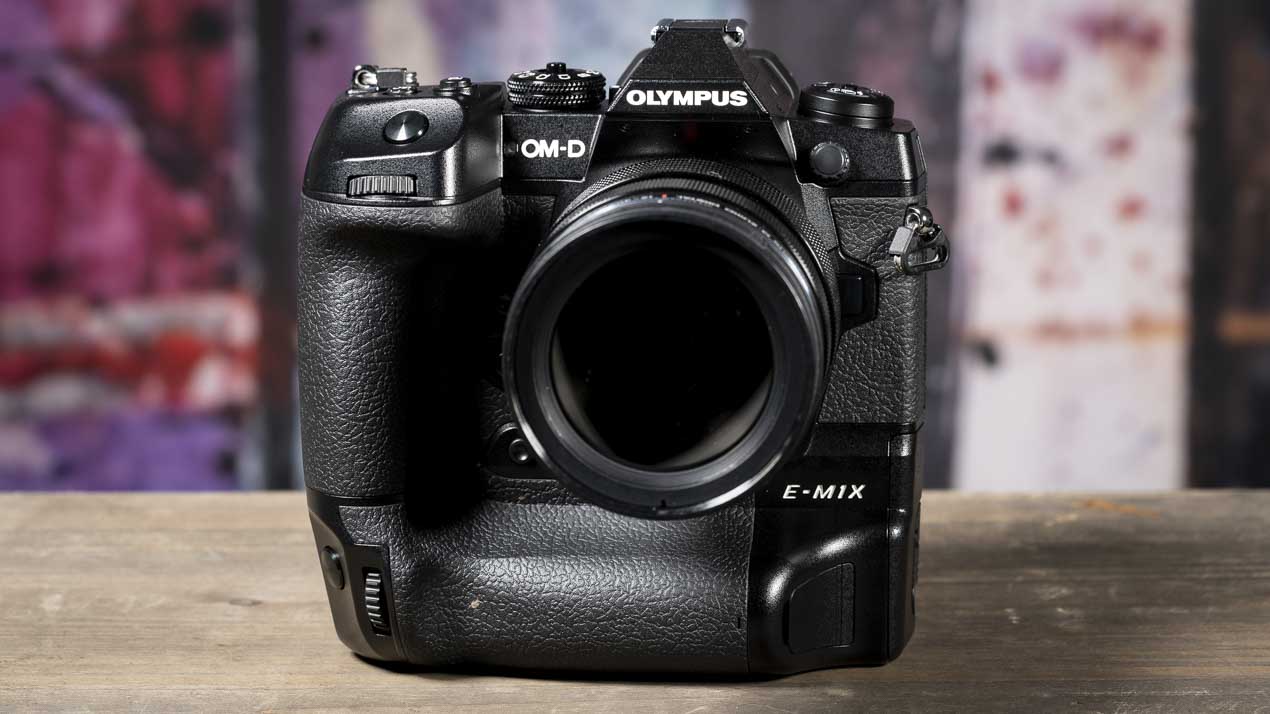
Specification
- Camera type: Mirrorless
- Sensor: 20.4Mp Four Thirds Type (17.3 x 13.0mm) CMOS
- Lens mount: Micro Four Thirds
- Sensitivity range: ISO 64-25,600
- Processing engine: 2x TruePic VIII
- Autofocus system: Hybrid with 121 cross-type points (800 in magnified view)
- Max continuous shooting rate: 18fps with AF tracking, 60fps with AF locked on first frame with electronic shutter
- Pro Capture High Mode: 60fps
- Pro Capture Low Mode: 18fps
- Burst Mode in S-AF: 15fps for 143 raw files
- Burst Mode in C-AF: 10fps for 283 raw files
- Max video resolution: 4K (4096 x 2160) at 24p
- Viewfinder: Electronic with 2,360,000 dots
- Screen: Touch-sensitive vari-angle 3-inch LCD with 1,037,000 dots
- Storage: 2x SD/SDHC/SDXC (UHS-II)
- Dimensions (WxHxD): 144.4 x 146.8 x 75.4mm
- Weight: 849g (body only), 997g (including 2 batteries and memory cards)
The OM-D E-M1X is a doubled-gripped mirrorless camera. It uses Olympus’s Pro Capture mode for shooting stills of very fast action. Thanks to the dual processors, there’s also no blackout in the viewfinder when this is in action.
In Pro Capture High mode, the shooting rate is 60fps, but the focusing is fixed at the start of the sequence. Switch to Pro Capture Low, and you can shoot at 18fps with continuous focusing.
Pro Capture mode is designed to help you record fleeting moments that are easily missed. To that end, when it’s activated the camera starts writing images to the buffer as soon as the shutter release is half-pressed. Once the shutter button is pressed fully, the 35 images that were buffered immediately before it was pressed are recorded along with 100 from immediately after.
There’s also a standard sequential shooting mode that uses the mechanical shutter. When this is in action, the maximum shooting rate in single AF mode is 15fps for 143 raw files. In continuous autofocus mode, the maximum is 10fps for 283 raw files.
A High Res Shot mode also delivers larger and more detailed images. The 50Mp Handheld mode captures the images quickly but then takes a little longer to render the final shot than the Tripod mode. Comparing the results with standard images reveals a nice jump in the level of detail.
Similarly, the 80Mp tripod mode delivers impressive results. It gives a significant boost to the size of print that you can make. That compositing also has a beneficial effect on the dynamic range as there’s more detail visible (and extractable) from the shadows.
£2199
$1999For
- One of the fastest cameras you can buy
- Pro Capture Mode offers lots of flexibility
- High Res Shot mode is very impressive


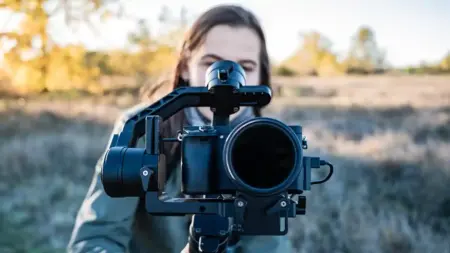
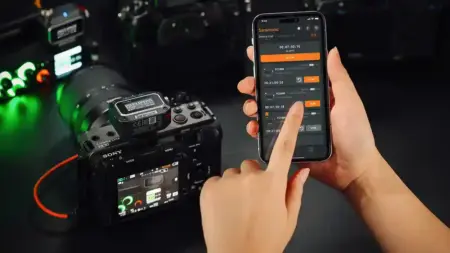
Leave a Reply